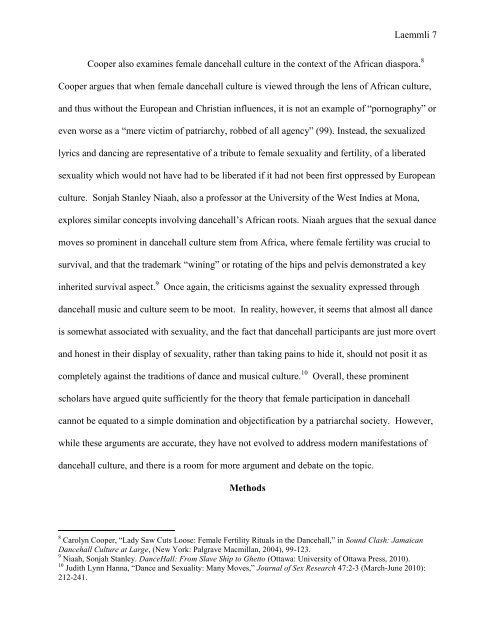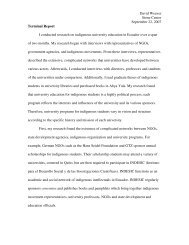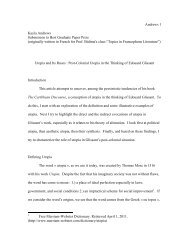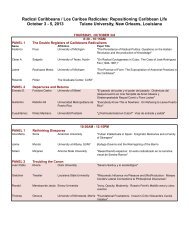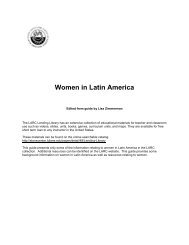Dancehall Queens and the Sale of Female Empowerment
Dancehall Queens and the Sale of Female Empowerment
Dancehall Queens and the Sale of Female Empowerment
Create successful ePaper yourself
Turn your PDF publications into a flip-book with our unique Google optimized e-Paper software.
Laemmli 7<br />
Cooper also examines female dancehall culture in <strong>the</strong> context <strong>of</strong> <strong>the</strong> African diaspora. 8<br />
Cooper argues that when female dancehall culture is viewed through <strong>the</strong> lens <strong>of</strong> African culture,<br />
<strong>and</strong> thus without <strong>the</strong> European <strong>and</strong> Christian influences, it is not an example <strong>of</strong> “pornography” or<br />
even worse as a “mere victim <strong>of</strong> patriarchy, robbed <strong>of</strong> all agency” (99). Instead, <strong>the</strong> sexualized<br />
lyrics <strong>and</strong> dancing are representative <strong>of</strong> a tribute to female sexuality <strong>and</strong> fertility, <strong>of</strong> a liberated<br />
sexuality which would not have had to be liberated if it had not been first oppressed by European<br />
culture. Sonjah Stanley Niaah, also a pr<strong>of</strong>essor at <strong>the</strong> University <strong>of</strong> <strong>the</strong> West Indies at Mona,<br />
explores similar concepts involving dancehall’s African roots. Niaah argues that <strong>the</strong> sexual dance<br />
moves so prominent in dancehall culture stem from Africa, where female fertility was crucial to<br />
survival, <strong>and</strong> that <strong>the</strong> trademark “wining” or rotating <strong>of</strong> <strong>the</strong> hips <strong>and</strong> pelvis demonstrated a key<br />
inherited survival aspect. 9<br />
Once again, <strong>the</strong> criticisms against <strong>the</strong> sexuality expressed through<br />
dancehall music <strong>and</strong> culture seem to be moot. In reality, however, it seems that almost all dance<br />
is somewhat associated with sexuality, <strong>and</strong> <strong>the</strong> fact that dancehall participants are just more overt<br />
<strong>and</strong> honest in <strong>the</strong>ir display <strong>of</strong> sexuality, ra<strong>the</strong>r than taking pains to hide it, should not posit it as<br />
completely against <strong>the</strong> traditions <strong>of</strong> dance <strong>and</strong> musical culture. 10<br />
Overall, <strong>the</strong>se prominent<br />
scholars have argued quite sufficiently for <strong>the</strong> <strong>the</strong>ory that female participation in dancehall<br />
cannot be equated to a simple domination <strong>and</strong> objectification by a patriarchal society. However,<br />
while <strong>the</strong>se arguments are accurate, <strong>the</strong>y have not evolved to address modern manifestations <strong>of</strong><br />
dancehall culture, <strong>and</strong> <strong>the</strong>re is a room for more argument <strong>and</strong> debate on <strong>the</strong> topic.<br />
Methods<br />
8 Carolyn Cooper, “Lady Saw Cuts Loose: <strong>Female</strong> Fertility Rituals in <strong>the</strong> <strong>Dancehall</strong>,” in Sound Clash: Jamaican<br />
<strong>Dancehall</strong> Culture at Large, (New York: Palgrave Macmillan, 2004), 99-123.<br />
9 Niaah, Sonjah Stanley. DanceHall: From Slave Ship to Ghetto (Ottawa: University <strong>of</strong> Ottawa Press, 2010).<br />
10 Judith Lynn Hanna, “Dance <strong>and</strong> Sexuality: Many Moves,” Journal <strong>of</strong> Sex Research 47:2-3 (March-June 2010):<br />
212-241.


